Aloha, adventurers! Beyond Oahu’s famous beaches lies a different paradise – a lush interior crisscrossed with trails leading to breathtaking waterfalls. Imagine stepping into a world painted in vibrant greens, the air filled with the scent of tropical flowers, the soundtrack a symphony of birdsong and rushing water. That’s the promise of an Oahu waterfall hike.
This island offers a fantastic variety of waterfall trails, from easy strolls to more challenging treks. Whether you seek a powerful cascade or a gentle fall hidden in a bamboo forest, there’s an adventure waiting. So, lace up your boots, pack your sense of adventure, and let’s explore some of the best waterfall hikes Oahu has to offer!
1. Manoa Falls Trail: The Accessible Giant
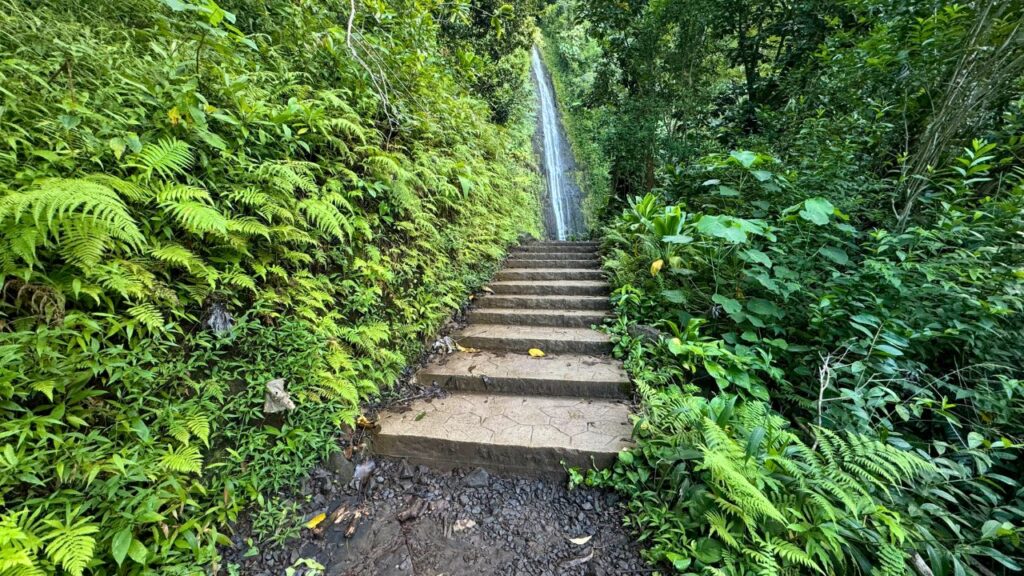
Perhaps the most well-known and accessible waterfall hike on Oahu, Manoa Falls offers a stunning reward for relatively moderate effort. Located just a short drive from Waikiki in the lush Manoa Valley, stepping onto this trail feels like entering a different world – one potentially familiar if you’re a fan of Jurassic Park or Lost, as scenes from both were filmed here.
The air instantly feels cooler, damper. The sheer scale of the vegetation is striking – giant elephant ear plants, towering banyan trees with their intricate root systems, and dense groves of bamboo that creak and sway in the breeze. It truly feels prehistoric.
Hike Details:
| Feature | Detail |
| Difficulty | Easy to Moderate |
| Length | Approx. 1.6 miles (2.6 km) roundtrip |
| Elevation Gain | Approx. 633 feet (193 m) |
| Est. Time | 1 – 2 hours |
| Permit Needed? | No (Parking fee usually applies) |
| Swimming? | Not recommended/often prohibited (risk of rockfall, water quality) |
The Trail Experience: The path starts relatively wide and gravelly but soon transitions into a more typical forest trail. While maintained, it’s almost perpetually damp and often muddy, especially after rain. Good footwear is essential! The incline is gradual but steady. You’ll wind your way through incredible flora, including fragrant ginger flowers, massive ferns, and those enchanting bamboo forests. The sound of the stream accompanies you for much of the hike.
The Waterfall: After navigating the final, slightly rockier section, you arrive at the base of Manoa Falls. It’s an impressive sight – a tall, thin cascade plunging approximately 150 feet down a sheer rock face into a small, rocky pool below. The amount of water varies significantly depending on recent rainfall; sometimes it’s a powerful torrent, other times a more gentle ribbon. While tempting, swimming here is generally discouraged due to the risk of falling rocks and potential water contamination (Leptospirosis). Take your photos, soak in the majestic view, and feel the cool spray.
Pros & Cons:
| Pros | Cons |
| Highly accessible from Honolulu | Can be very crowded |
| Stunning, lush rainforest scenery | Often extremely muddy |
| Relatively short and moderate hike | Swimming not advised/allowed |
| Well-maintained (though muddy) path | Parking lot can fill quickly; fee required |
Manoa Specific Tips:
- Go early in the morning on a weekday to avoid the biggest crowds.
- Embrace the mud – wear shoes you don’t mind getting dirty.
- Bring rain gear; Manoa Valley is one of the wettest spots on Oahu.
- Consider visiting the nearby Lyon Arboretum afterwards for more botanical beauty.
2. Maunawili Falls Trail: The Muddy Adventure Pool
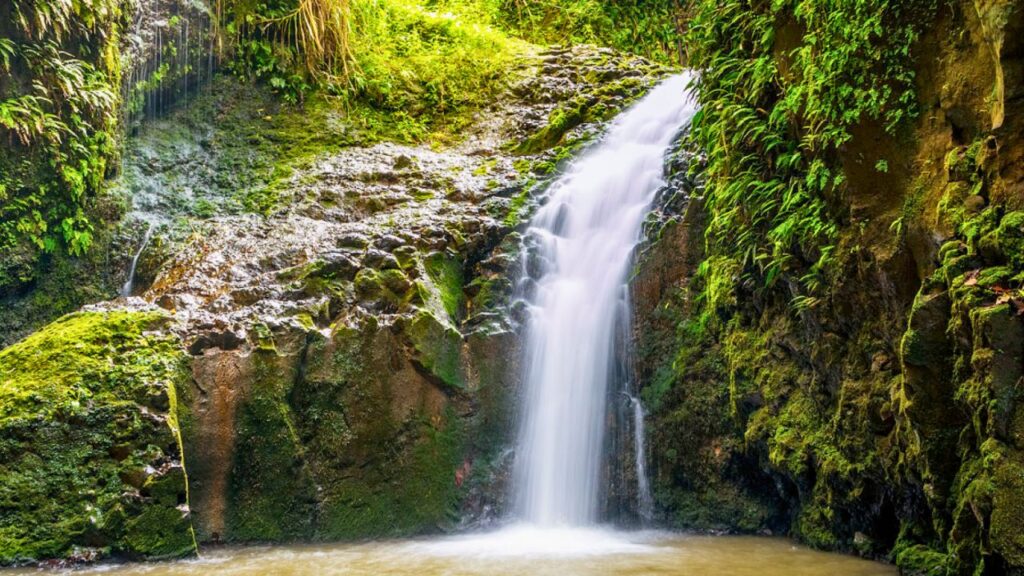
If Manoa is the accessible giant, Maunawili is its wilder, muddier cousin, known for its fun swimming hole at the end. This hike, located on the windward side near Kailua, offers a true jungle adventure feel, complete with stream crossings and notoriously muddy conditions. Note: Trail access has sometimes been restricted or rerouted due to land ownership issues; always check the current status before planning your hike.
My most vivid memory of Maunawili isn’t just the waterfall, but the journey. Scrambling over roots, navigating slick mud patches that threatened to steal my shoes, and the refreshing shock of wading through the cool stream crossings – it felt like a proper expedition!
Hike Details:
| Feature | Detail |
| Difficulty | Moderate |
| Length | Approx. 2.8 – 3 miles (4.5 – 4.8 km) roundtrip |
| Elevation Gain | Approx. 500-600 feet (150-180 m) |
| Est. Time | 2 – 3 hours |
| Permit Needed? | No (but check access status/route) |
| Swimming? | Yes, popular swimming hole (use caution) |
The Trail Experience: Get ready for mud. Seriously, Maunawili is arguably the muddiest popular hike on Oahu. Wear appropriate footwear (that you really don’t mind getting wet and filthy) and be prepared to potentially slip and slide. The trail takes you through lush forest, featuring several stream crossings. Some crossings might require wading up to your knees depending on water levels. The path can sometimes be confusing with side trails; stick to the most worn path and follow any available markers. Despite the mud, the scenery is beautiful, with dense vegetation and the sounds of the forest all around.
The Waterfall: The reward for braving the mud is a beautiful waterfall cascading into a large, inviting pool. This is a popular spot for swimming and cooling off after the hike. You’ll often see people jumping from rock ledges into the pool – exercise extreme caution if you choose to do this, check water depth, and be aware of submerged rocks. Even just sitting by the pool and enjoying the view is a fantastic payoff.
Pros & Cons:
| Pros | Cons |
| Great swimming hole | EXTREMELY muddy trail |
| Adventurous jungle feel | Parking is notoriously difficult/limited |
| Beautiful waterfall payoff | Trail access/route can be uncertain/change |
| Multiple fun stream crossings | Can be very crowded, especially at the pool |
| Potential for confusing trail junctions | |
| Respect for neighborhood residents crucial |
Maunawili Specific Tips:
- Check Trail Status: Absolutely verify the trail is open and accessible via the intended route before you go. Look for recent updates on state park sites or hiking forums.
- Parking: This is a major issue. The trailhead is in a residential neighborhood. Arrive extremely early (before 7 AM) or go on a weekday. Park legally and be very quiet and respectful of residents. Do NOT block driveways. Consider ride-sharing or getting dropped off.
- Footwear: Old sneakers or sturdy hiking sandals you can get wet are best. Some people hike barefoot, but rocks and roots make this risky.
- Bring a Towel: You’ll want it after swimming or just for cleaning off mud.
- Leptospirosis: Be mindful of the risks associated with swimming in freshwater streams.
3. Waimea Falls (Waihi Falls): The Cultural Garden Stroll

For a completely different waterfall experience, head to the North Shore’s Waimea Valley. This isn’t a rugged hike in the traditional sense, but rather a pleasant walk through a stunning botanical garden and cultural site that culminates in a beautiful waterfall where you can swim under lifeguard supervision.
Walking through Waimea Valley is a journey through Hawaiian history and Polynesian botany. I loved meandering along the paved path, reading about the significance of the different plant species and stopping at the reconstructed Hawaiian living sites (hale). It felt less like a hike and more like an immersive cultural experience, with the waterfall as the grand finale.
Hike Details:
| Feature | Detail |
| Difficulty | Easy |
| Length | Approx. 1.5 miles (2.4 km) roundtrip on paved path |
| Elevation Gain | Minimal |
| Est. Time | 1 – 1.5 hours (plus time for gardens & swimming) |
| Permit Needed? | No, but Entry Fee Required (part of Waimea Valley) |
| Swimming? | Yes, lifeguarded (life vests required & provided) |
The Trail Experience: The entire path leading to the waterfall is paved and relatively flat, making it accessible for strollers, wheelchairs, and hikers of all abilities. The route winds through the breathtaking Waimea Valley botanical gardens, showcasing an incredible collection of native Hawaiian and Polynesian plants, as well as species from around the world. Along the way, you’ll pass several reconstructed traditional Hawaiian cultural sites, offering glimpses into the past. It’s a relaxing and educational walk. Golf cart shuttles are sometimes available for an extra fee if mobility is a concern.
The Waterfall: Waihi Falls, commonly known as Waimea Falls, cascades about 45 feet into a large, clear pool. The setting is picturesque, surrounded by lush foliage. What makes this waterfall unique among the popular choices is the managed swimming experience. Swimming is allowed when conditions permit (check upon arrival), and lifeguards are on duty. Life vests are mandatory for all swimmers and are provided free of charge. Changing rooms are also available near the falls.
Pros & Cons:
| Pros | Cons |
| Paved, easily accessible path | Entry fee required for Waimea Valley |
| Stunning botanical gardens & cultural sites | Can feel more touristy than a wild hike |
| Safe, lifeguarded swimming | Swimming area can close due to weather/conditions |
| Suitable for all ages and abilities | Less adventurous than other waterfall hikes |
| Facilities available (restrooms, cafe) | Can be crowded |
Waimea Specific Tips:
- Allow ample time (at least 2-3 hours total) to fully appreciate the botanical gardens and cultural sites, not just the waterfall.
- Bring your swimsuit and towel if you plan to swim.
- Check the Waimea Valley website for current hours, admission fees, and swimming status before you go.
- Consider exploring the rest of the North Shore while you’re in the area.
4. Lulumahu Falls: The Permitted Treasure
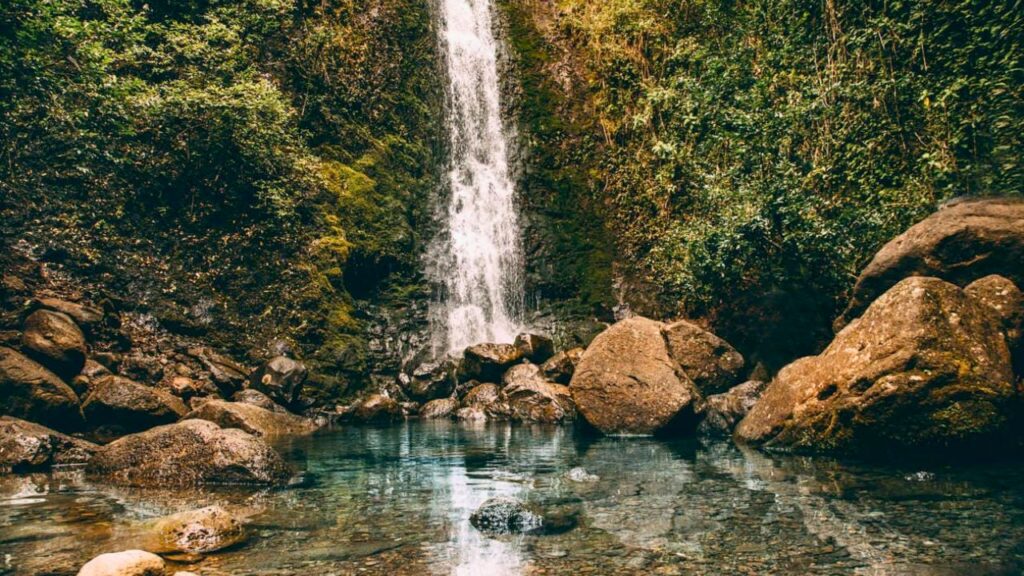
For those seeking a bit more adventure and a truly impressive waterfall off the main tourist track, Lulumahu Falls is a fantastic choice. However, this hike comes with a crucial requirement: you MUST obtain a permit in advance. Located in the Nu’uanu Valley off the Pali Highway, this trail involves navigating through bamboo forests, crossing streams, and following a less-defined path to reach a spectacular, multi-tiered cascade.
Finding the trailhead itself feels like part of the adventure, starting near the Board of Water Supply reservoir. I remember feeling a sense of accomplishment navigating the sometimes-ambiguous trail, following the pink and orange ribbons tied to trees, and finally emerging into the rocky basin below the towering falls. The scale of Lulumahu is truly impressive.
Hike Details:
| Feature | Detail |
| Difficulty | Moderate |
| Length | Approx. 2 miles (3.2 km) roundtrip |
| Elevation Gain | Approx. 800 – 1000 feet (240 – 300 m) |
| Est. Time | 1.5 – 2.5 hours |
| Permit Needed? | YES – Absolutely Required (from DLNR/Na Ala Hele) |
| Swimming? | Generally not recommended (shallow pool, water quality) |
The Trail Experience: The hike starts along an access road past the Nu’uanu Reservoir before ducking into the forest. Do not attempt this hike without securing the permit online from the Hawaii Department of Land and Natural Resources (DLNR) Na Ala Hele Trail & Access System website beforehand. Rangers do patrol, and fines can be issued. The trail itself can be muddy and involves multiple stream crossings. It’s not always clearly marked, so hikers often rely on following the stream and looking for colored ribbon markers left by previous hikers. You’ll traverse through dense bamboo forests and navigate over rocks and roots. Some minor scrambling may be required near the end. Downloading an offline map or using a GPS hiking app is highly recommended.
The Waterfall: Lulumahu Falls is arguably one of the most stunning waterfalls on Oahu. It’s a tall, multi-tiered cascade (estimated around 50+ feet) plunging into a rocky amphitheater. The sheer volume of water can be impressive, especially after heavy rains. The surrounding moss-covered rocks and lush vegetation create a dramatic and photogenic scene. While there’s a pool at the base, it’s typically shallow and rocky, making swimming unappealing and potentially unsafe.
Pros & Cons:
| Pros | Cons |
| Spectacular, tall waterfall | Permit is absolutely mandatory |
| More adventurous, less crowded feel | Trail can be confusing and poorly marked |
| Beautiful bamboo forest sections | Requires stream crossings; can be very muddy |
| Feels more “off-the-beaten-path” | No swimming |
| Parking is along Pali Hwy; be cautious |
Lulumahu Specific Tips:
- Get Your Permit: Apply online via the Na Ala Hele website well in advance. Print it out or have a digital copy accessible. This is non-negotiable.
- Navigation: Download an offline map (like AllTrails app) and pay close attention to trail markers (ribbons) and the stream. It’s easy to take a wrong turn.
- Footwear: Sturdy, waterproof hiking boots are best due to mud and stream crossings.
- Parking: Park carefully along the Pali Highway near the Hawaii Nature Center/Board of Water Supply access point. Be mindful of traffic and ensure your car is completely off the road.
5. Likeke Falls: The Short & Sweet Reward
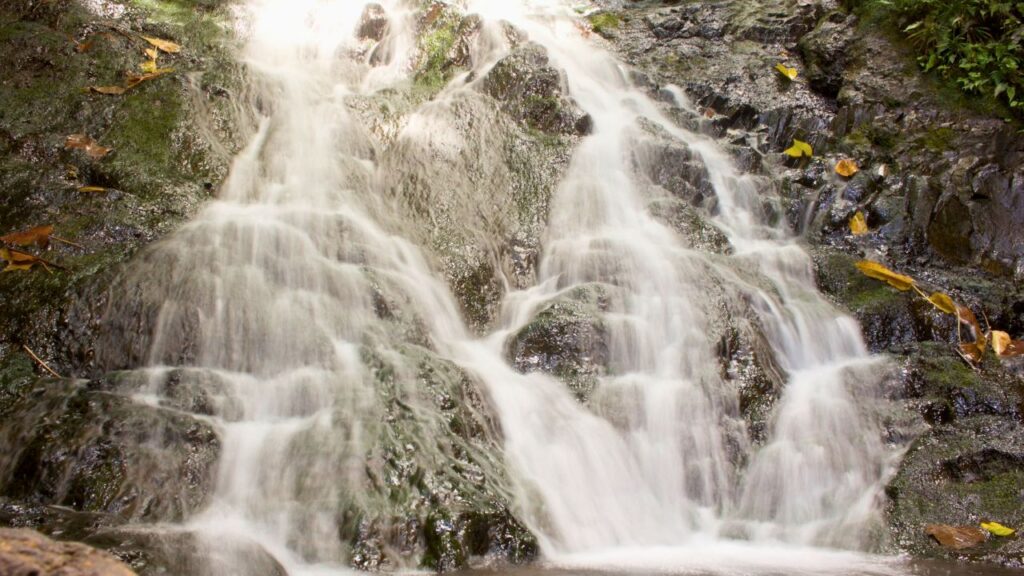
If you’re short on time or looking for an easier waterfall fix, Likeke Falls (pronounced Lee-keh-keh) is an excellent option. Tucked away near the Ko’olau Golf Club and the Pali Lookout, this trail leads to a charming, multi-tiered waterfall that requires relatively little effort to reach.
This hike often feels like a cool, quick escape. I particularly enjoy the contrast – one minute you’re near civilization (or the historic Pali Lookout), the next you’re descending into a quiet, green gully following the sound of water. It’s perfect for when you want a nature boost without committing to a multi-hour trek.
Hike Details:
| Feature | Detail |
| Difficulty | Easy |
| Length | Approx. 0.8 miles (1.3 km) roundtrip (from shorter trailhead) |
| Elevation Gain | Approx. 200 feet (60 m) |
| Est. Time | 30 – 60 minutes |
| Permit Needed? | No |
| Swimming? | Minimal wading/splashing possible (shallow pool) |
The Trail Experience: There are technically two main ways to reach Likeke Falls. The most common and shorter route starts near the back of the Ko’olau Golf Club parking lot (park respectfully in designated hiker spots if available, or consider parking carefully along the Old Pali Road). This path descends gently through the forest. A longer, slightly more confusing route involves starting from the Pali Lookout and carefully navigating down paths near the highway tunnels – the shorter route is generally recommended for simplicity. The trail itself is relatively clear but can be muddy and involves navigating some tree roots. It follows along a stream leading directly to the falls.
The Waterfall: Likeke Falls is a pretty, multi-tiered cascade, perhaps around 15-20 feet tall in total. Water flows over mossy rocks into a shallow pool. It might not have the dramatic plunge of Manoa or Lulumahu, but it has a serene charm. The shallow pool allows for some wading or splashing to cool off, but it’s not deep enough for swimming. It’s a lovely spot for photos and enjoying a peaceful moment in nature.
Pros & Cons:
| Pros | Cons |
| Short and relatively easy hike | Waterfall is smaller than others |
| Accessible location | Can be muddy, especially after rain |
| Good option for families or beginners | Parking can be confusing/limited depending on start |
| Pleasant forest scenery | Pool is shallow, not for swimming |
Likeke Specific Tips:
- Clarify your starting point – the trailhead near the Ko’olau Golf Club maintenance shed/water tank is generally the easiest. Check recent trail reports for the best access information.
- Combine this hike with a visit to the nearby Pali Lookout for stunning panoramic views of the windward coast.
- Even though it’s short, wear proper shoes as it can still be slippery.
Other Notable Oahu Waterfall Hikes
While the falls above are often considered the “best” due to accessibility and payoff, Oahu has other trails featuring cascades worth mentioning:
- Jackass Ginger Pool (Judd Trail): An easy, family-friendly loop trail in Nu’uanu featuring a small waterfall and a popular swimming hole (Jackass Ginger Pool). Great for kids, but can be crowded. Also requires caution regarding water quality.
- Kapena Falls: Located surprisingly close to Honolulu, this short walk leads to a small waterfall and pool historically significant in Hawaiian culture. Be aware it’s near a freeway overpass, so it lacks the remote feel of other hikes. Exercise caution as the area has had safety concerns at times.
- Waimano Falls: A more challenging hike involving steep switchbacks (‘cardiac hill’) leading down into a valley with a multi-level waterfall and swimming pools. Requires good fitness and careful footing.
- Laie Falls: A longer, moderate hike on the North Shore requiring a permit from Hawaii Reserves, Inc. (associated with the LDS church). Leads through varied terrain to a small waterfall.
Final Thoughts: Embrace the Adventure Responsibly
Hiking to a waterfall on Oahu is more than just reaching a destination; it’s about the journey through vibrant ecosystems, the challenge of the trail, and the connection with the island’s powerful natural beauty. From the accessible paths of Waimea to the muddy scrambles of Maunawili and the permitted quest to Lulumahu, there’s an adventure tailored to every preference.
Standing amidst the towering green walls of a valley, mist from the falls cooling your face, the sounds of nature filling your ears – it’s a pure, grounding experience.
As you venture out, please prioritize safety and respect. Check conditions, wear appropriate gear, and always practice Malama ‘Aina – care for the land. Pack out everything you bring in, stay on marked trails, and be considerate of local residents and fellow hikers.
Oahu’s waterfalls are waiting. Go discover their magic! Happy hiking!
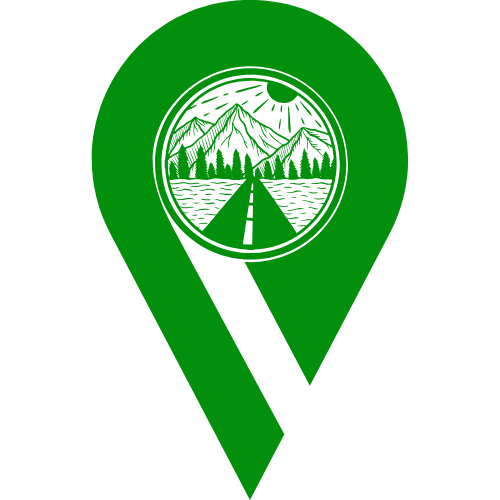
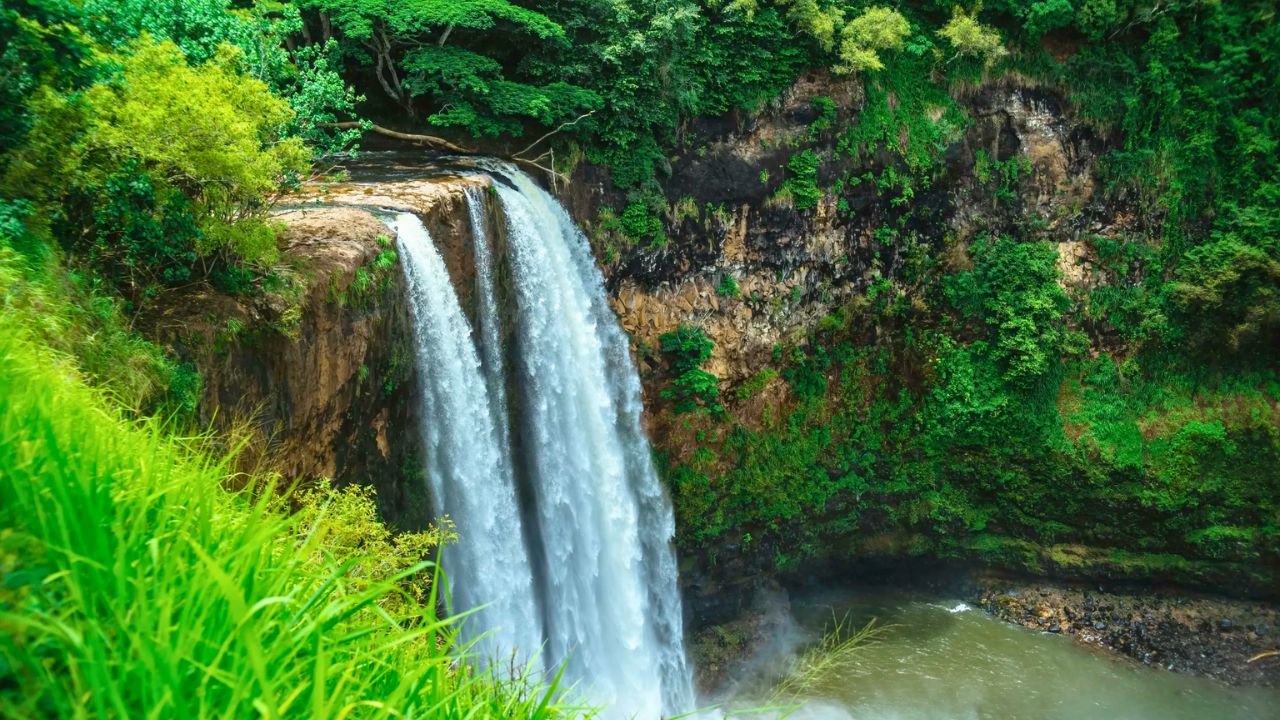
Leave a Reply